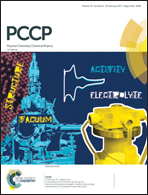Photocleavage of coumarin dimers studied by femtosecond UV transient absorption spectroscopy†
Abstract
Coumarins are a class of UV absorbing compounds which exhibit fast, photoinduced cyclobutane ring formation and cleavage reactions. The photophysics behind such processes hold significant relevance for biomedical and photoresponsive materials research. In order to further understand the underlying dynamics of the cleavage reaction, and develop strategies for increasing the reaction efficiency, UV transient absorption spectroscopy was applied to three unsubstituted, isomeric coumarin dimers: anti-head-to-head (anti-hh), syn-head-to-head (syn-hh) and syn-head-to-tail (syn-ht). The experiments performed under 280 nm excitation and broadband (300–620 nm) probing revealed that the cleavage reaction of coumarin dimers occurs through non-radiative, short-lived (<200 fs) singlet states. From the data, two branched kinetic models were developed to describe the monomer formation and dimer relaxation dynamics, identify possible intermediate states, and determine the quantum yields of the dimer cleavage. The anti-hh dimer shows the highest cleavage efficiency with a value of about 20%. The differences in the cleavage efficiency for the three isomers are interpreted in terms of differing steric hindrances of the benzene groups attached to the cyclobutane ring and charge delocalisation of the intermediate state.



 Please wait while we load your content...
Please wait while we load your content...